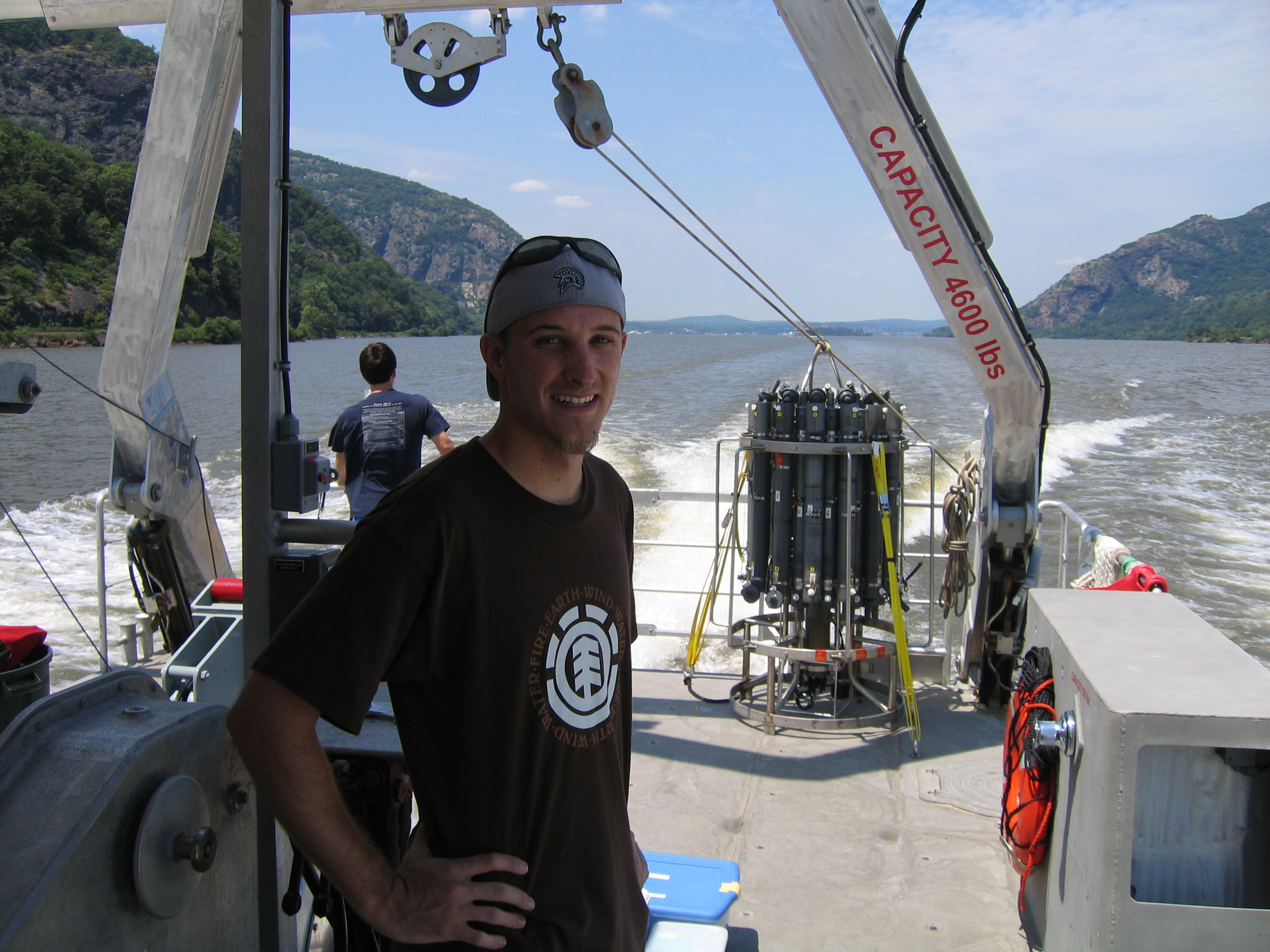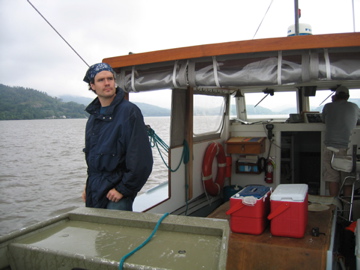The aquatic behavior of rhenium and molybdenum
We have recently revised estimates of the concentration of rhenium in rivers (11.2 pM, pre-human; 16.5 pM today) and its residence time in seawater (130,000 years, pre-human).
Since the seminal contribution by Debbie Colodner an coworkers at MIT (EPSL 117, 205-221, 1993; EPSL 131, 1-15, 1995), Re has been considered a conservative element in seawater (~40 pM) and freshwater (~2 pM) with a long marine residence time (~750,000 years). Starting with Summer Student Fellow Brett Walker (UCSC), we decided to take a fresh look at the behavior of Re (and Mo) in river system. In July 2004, we joined a group of physical oceanographers (Jim Lerczak and Rocky Geyer, both at WHOI) on a cruise with R/V TIOGA, the newest addition to the WHOI fleet, to the Hudson River. This research was sponsored by the WHOI Summer Student Fellowship Program and support by Pancha and Karl Peterson. Brett presented his data for the contaminated Hudson River at the 2004 Fall AGU meeting in San Francisco and at the 2005 ASLO Conference in Salt Lake City (Outstanding Student Poster Award). With NSF-EAR funding (grant EAR-0519387) MIT/WHOI Joint Program student Christian Miller and I have since been back to the Hudson on the RIVERKEEPER patrol boat with Cptn. John Lipscomb of the Riverkeepter Org. (see photo) to track down the source of Re to the Hudson. With the help of students of schools along the Hudson River (Snapshot Day program, LDEO) we found the Re, probably of industrial origin, is released into the Hudson just north of the Federal Dam at Troy, NY.
Commercial use of Re for metallurgical purposes (~75% of the use of Re) and petroleum refining (~20%, production of high-octane fuel) consumes about 20,000 kg Re per year in the U.S. alone. Christian Miller and our team have recently shown (Geochimica et Cosmochimica Acta 75, 7146-7179, 2011) that Re is released into the environment by industrial processes, including mining and coal burning. About one third of the dissolved Re in rivers is from human contamination. Debbie Colodner et al. (1995) hinted at such contamination in their work on rivers draining into the Black Sea, speculating that such contamination may be pervasive in industrialized regions.
In collaboration with Franco Marcantonio (TAMU), we have expanded our investigation to Re and Mo concentrations in the Mississippi River and its major tributaries. Collaborations with Pete Raymond (Yale University) and Max Holmes (Woods Hole Research Center - NSF-funded PARTNERS Project) allowed us to also investigate the flux of Re and Mo from major rivers draining into the Arctic Ocean.
River Sampling: Most of our sampling of global river system has been done with a a simple syringe-filtration method for sampling small (125 ml) volumes of river water. The method involves sampling rivers with the help of a 12-feet plastic dipper (see photo 2). Water is then sucked into a plastic syringe and pressed through a 0.22 or 0.45 micrometer cartridge filter into precleaned plastic bottles. The cost of sampling is about $10 per sample and can be done by untrained helpers.
Overall Findings:
Global dissolved Re concentration in rivers today: 16.5 pM
Global dissolved Re concentration pre-human: 11.2 pM
Global dissolved Mo concentration in rivers today: 8.0 pM
Marine residence time of Re: 130,000 years
Partners/Collaborators
Brett Walker (UCSC) Christian Miller (MIT/WHOI JP student) Prof. Franco Marcantonio (Tulane Univ./TAMU) Prof. Pete Raymond (Yale University) Max Holmes (Woods Hole Research Center) Schlumberger's SEED Program, and many colleagues worldwide who sampled rivers for us.

Brett Walker (REU from UCSC) on the R/V Tioga cruising up the Hudson River to take water samples for Re and Mo analyses.

Dr. Petra with the dipper, sampling a stream in the Catskill Mountains on a soggy day in October 2004. Filtered water samples from Hudson River tributaries will be analyzed by isotope dilution ICPMS for rhenium and molybdenum concentrations.

Christan Miller (left) and Cpt. John Lipscomb (right) on the RIVERKEEPER patrol boat on the Hudson River (June 2006).